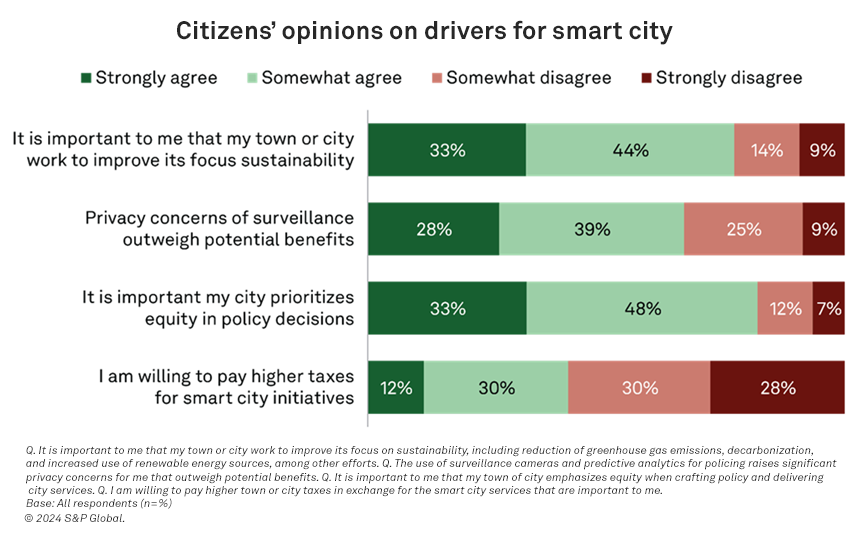
In 2023, as cities navigated their way forward from the pandemic, several notable trends emerged that will likely continue into 2024 and beyond. While numerous smart city projects remain centered on transportation and mobility enhancements, many cities have ramped up their efforts to build out their fiber infrastructure using federal/central funding, focused smart city outcomes around resilience and sustainability, and cautiously looked toward AI capabilities as a potential ally — and adversary.
The Take
Smart city priorities and implementations have lived through many iterations since the concept was introduced over a decade ago. While the early movement saw cities looking to move fast and deploy point services across public safety, traffic management and connected spaces via Wi-Fi, the COVID-19 outbreak shifted the movement in two major ways. It released millions in federal funding for cities to recover and invest in their digital and physical infrastructure upgrades, and it acted as a reset button on city prioritizations. Rather than seeking potentially disjointed point services that reinforced data siloes across city departments, cities are going back to the basics and outlining the digital connectivity they will need to achieve long-term, outcome-based smart city goals. After all, achieving a smart and connected city is a marathon, not a sprint.
Details
The following are three major 2023 trends in the US and European smart city markets.
Fiber focus
Metros have looked to bolster their enabling physical and digital infrastructure to enhance smart city and transportation projects, namely in fiber and fiber-to-the-home initiatives. Recent Kagan research shows that 16% of North American households had residential fiber penetration, lagging behind Latin America (26%), Western Europe (30%), Eastern Europe (35%) and Asia-Pacific (45%).
In line with Europe’s Digital Decade goals of providing fixed-gigabit network access for all EU households, the EU has allocated roughly $120 billion for digital infrastructure and transformation projects through the Recovery and Resilience Facility from the EU’s 2021 to 2027 multiannual financial framework. In February, the European Commission also introduced the Gigabit Infrastructure Law to foster the deployment of advanced fiber and 5G networks by simplifying network deployment.
In the US, states can leverage Broadband, Equity, Access and Deployment grants, along with allocations from the Bipartisan Infrastructure Law and Inflation Reduction Act, to expedite North American fiber/broadband deployments into 2024. In 2023, Chattanooga, Tenn.’s publicly owned utility, which introduced community-wide fiber in 2010, announced that it would deploy a commercially available quantum network, the first of its kind in the US.
Resilience and sustainability as drivers
Smart city projects have historically been motivated by safety, enhancing quality of life and delivering cost savings. As cities sit at the confluence of climate events, more municipalities are framing their smart city outcomes around reducing emissions, reaching sustainability targets and building resilience. When asked about their primary motivation for their city adopting new technologies, half of respondents to 451 Research’s recent Smart Cities survey cited resilience. Orlando has deployed a digital twin in efforts to enhance future-readiness, and the title Chief Heat Officer picked up steam in 2023 as cities like Miami, Phoenix and Athens sought to mitigate the community impact of extreme heat and urban heat islands.

AI — a double-edged sword
While 2023 has broadly been viewed as the year of AI developments, for cities, artificial intelligence can be a double-edged sword. Generative AI use cases for the public sector such as intelligent document processing and chatbots have emerged, in line with state- or city-level guidance on the use of generative AI tools. On a regional level, the EU AI Act was introduced in March to categorize the risk of various AI systems, promote transparency for those building foundation models, and bolster data quality and accountability.
Many IoT software platforms also come with AI-based analytics to optimize resource usage and inform simulations. However, while AI can make city employee life easier by optimizing times and resources, it can also exacerbate the threat landscape. AI can enhance the efficacy and scale of attacks, including those on critical infrastructure. As industrial control systems and IoT devices present entryways for hackers looking to exploit critical infrastructure, cities will likely respond with investments into operational technology/IoT security systems and hiring chief security and chief information security officers.
Want insights on IoT trends delivered to your inbox? Join the 451 Alliance.

